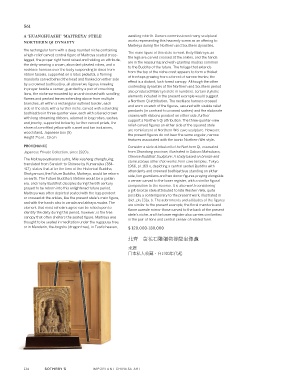Page 136 - Important Chinese Art Sothebys March 2019
P. 136
561
A ‘HUANGHUASHI’ ‘MAITREYA’ STELE awaiting rebirth. Donors commissioned many sculptural
NORTHERN QI DYNASTY works representing this heavenly scene as an offering to
maitreya during the northern and southern dynasties.
the rectangular form with a deep rounded niche containing the main figure of this stele is most likely maitreya, as
a high-relief carved central figure of maitreya seated cross- the legs are carved crossed at the ankles, and the hands
legged, the proper right hand raised and holding an attribute, are in the reassuring and wish-granting mudras common
the deity wearing a crown, abundant pleated robes, and a to the Buddha of the future. the foliage that extends
necklace harness over the body suspending bi discs from from the top of the niche crest appears to form a thicket
ribbon tassels, supported on a lotus pedestal, a flaming of treetops growing from a forest of narrow trunks; the
mandorla carved behind the head and flanked on either side effect is a distant, lush forest canopy. although the other
by a crowned bodhisattva, all above two figures kneeling contending dynasties of the northern and southern period
in prayer beside a censer, guarded by a pair of crouching also produced maitreya stele in numbers, certain stylistic
lions, the niche surmounted by an arch incised with scrolling elements included in the present example would suggest
flames and peaked leaves extending above from multiple a northern Qi attribution. the necklace harness crossed
branches, all within a rectangular outlined border, each and worn on each of the figures, secured with sizable relief
side of the stele with a further niche, carved with a standing pendants (in contrast to crossed sashes) and the elaborate
bodhisattva in three-quarter view, each with a tiered crown crowns with ribbons pendent on either side, further
with long streaming ribbons, adorned in long robes, sashes, support a northern Qi attribution. the three-quarter-view
and jewelry, supported below by further carved petals, the relief-carved figures on either side of the squared stele
stone of a mottled yellow with russet and tan inclusions, are reminiscent of northern Wei cave sculpture. however,
wood stand, Japanese box (5) the present figures do not bear the same angular, narrow
height 7½ in., 19 cm
features associated with the iconic northern Wei style.
PROVENANCE Consider a stele attributed to the northern Qi, excavated
Japanese private Collection, since 1920s. from shandong province, illustrated in saburo matsubara,
Chinese Buddhist Sculpture: A study based on bronze and
the maitreyavyākarana sutra, Mile xiasheng chengfo jing, stone statues other than works from cave temples, tokyo,
translated from sanskrit to Chinese by Kumarajiva (384- 1966, pl. 169 a, depicting a central seated Buddha with
417), states that after the time of the historical Buddha, attendants and crowned bodhisattvas standing on either
shakyamuni, the Future Buddha, maitreya, would be reborn side, lion guardians and two donor figures praying alongside
on earth. the Future Buddha’s lifetime would be a golden a censer carved to the lower register, with a similar figural
era, and many Buddhist disciples during the 6th century composition to the reverse. It is also worth considering
prayed to be reborn into this enlightened future period. a gilt-bronze stele attributed to late Western Wei, quite
maitreya was often depicted seated with the legs pendent possibly a contemporary to the present work, illustrated in
or crossed at the ankles, like the present stele’s main figure, ibid., pls 131a, b. the adornments and attitudes of the figures
and with the hands also in varada and abhaya mudra. the are similar to the present example, the floral mandorla and
element that most scholars agree can be relied upon to flame aureole mirror those carved to the back of the present
identify the deity during this period, however, is the tree stele’s niche, and the lower register also carries similarities
canopy that often shelters the seated figure. maitreya was in the pair of lions and central censer of related form.
thought to be seated in meditation under the nagapusa tree,
or in mandarin, the longshu (dragon tree), in Tusita heaven, $ 120,000-180,000
北齊 黃花石雕彌勒菩薩坐像龕
來源
日本私人收藏,自1920年代起
134 SOTHEBY’S Important ChInese art

